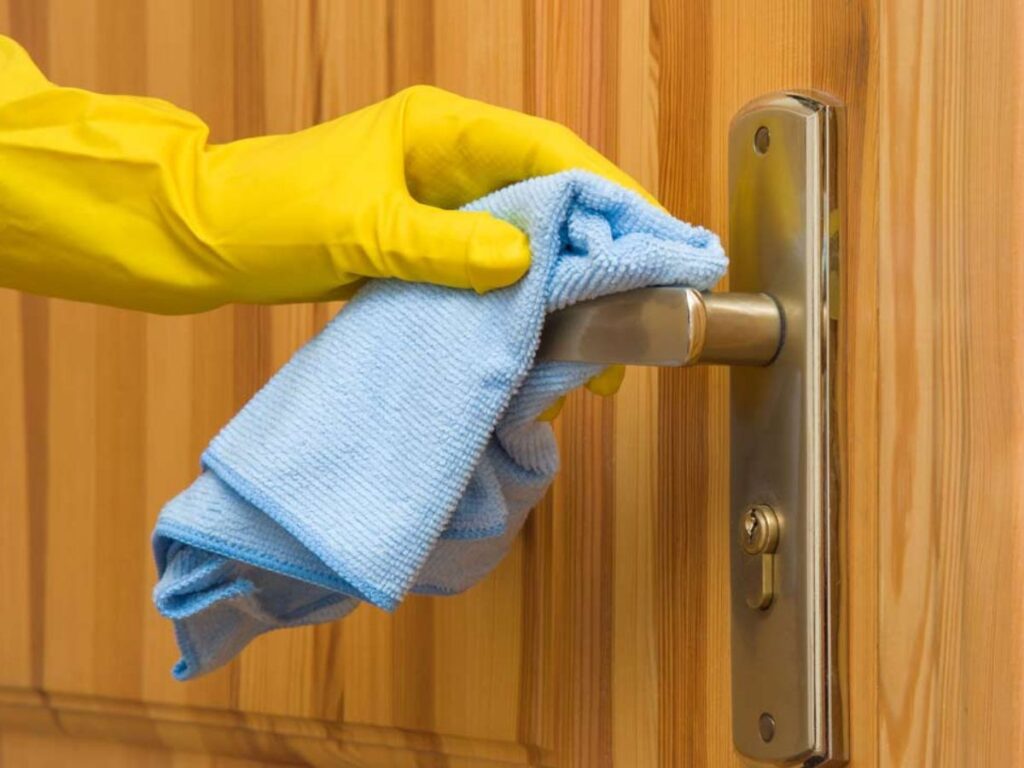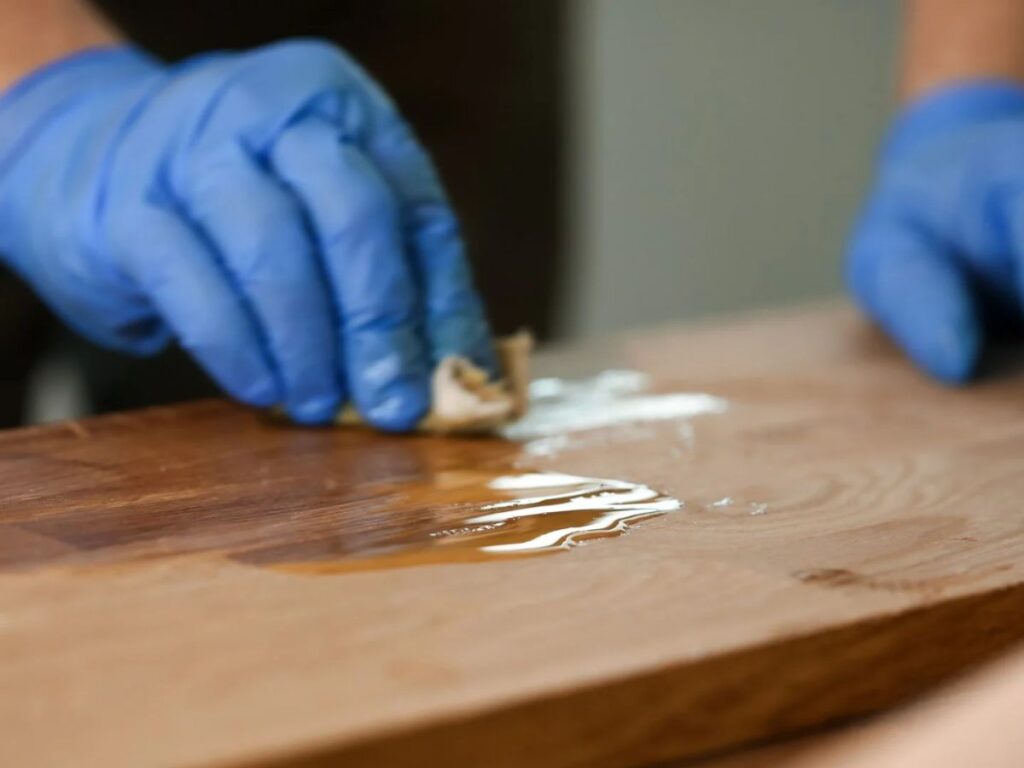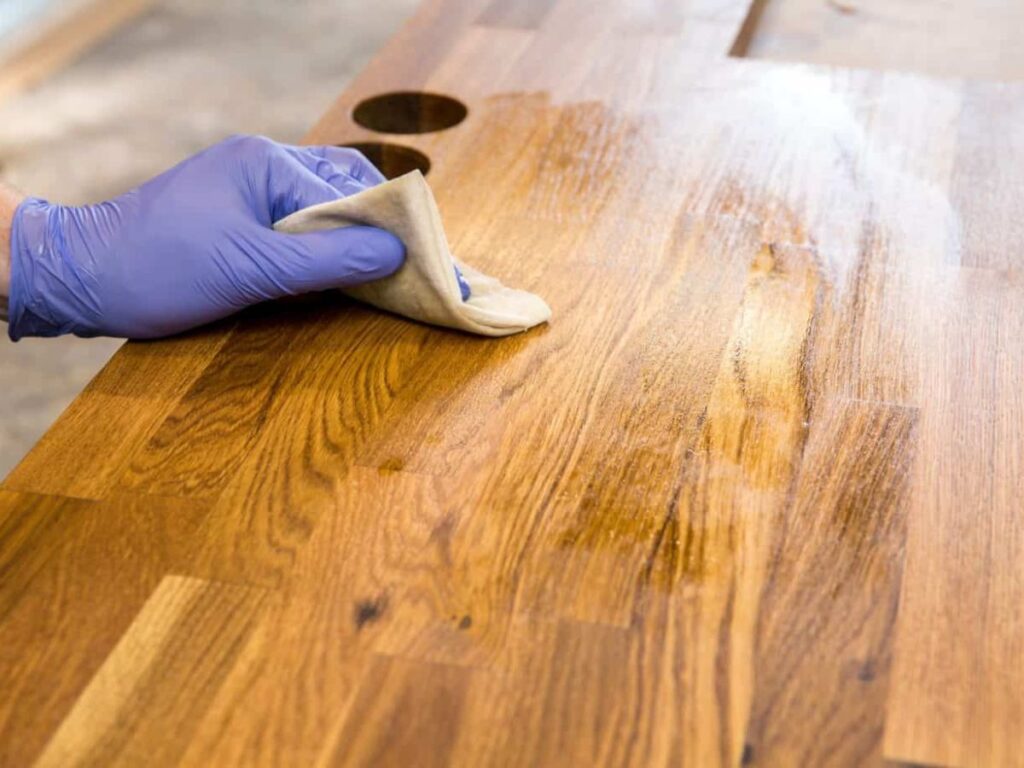I remember the first time I stained a hotel’s main entrance door. The wood had faded, and guests noticed before they even stepped inside. After the job, the owner said bookings improved because the entrance looked fresh again.
If you manage properties, you know first impressions matter. A front door is often the first thing people see.
I’ve worked with villas, hotels, and inns across Southeast Asia and Europe. My advice comes from hands-on experience with many projects, not theory.
In this guide, you’ll see a step-by-step way to stain a front door. You’ll know exactly what tools to prepare, how to work on the surface, and how to protect it for years.
A good finish can make your property stand out before anyone walks inside.
So let’s get started!
Quick Process Chart
Sometimes it’s helpful to see all the steps in one place. This table gives you a simple breakdown so you can follow the process without scrolling back and forth. You can use it as a checklist for your team or project plan.
| Step | Action | Key Focus | Why It Matters |
| 1 | Remove the Door (Optional) | Easier access, prevents drips | Better control and cleaner application |
| 2 | Remove All Hardware | Protects hardware, cleaner finish | Avoids damage and improves appearance |
| 3 | Clean the Door Thoroughly | Remove dust, dirt, and grease | Ensures stain absorbs evenly |
| 4 | Strip Old Finish (If Needed) | Bare wood for even stain absorption | Prevents uneven color and blotches |
| 5 | Sand the Entire Surface | Smooth surface, open wood grain | Improves adhesion and finish quality |
| 6 | Apply Wood Conditioner (Optional) | Prevents blotches, evens stain | Gives consistent color across the surface |
| 7 | Apply the Stain | Work with the grain, wipe excess | Enhances wood grain and color depth |
| 8 | Let the Stain Dry Fully | Avoid tacky surface, set color | Prevents smudges and topcoat failure |
| 9 | Apply a Protective Topcoat | Seal against moisture, UV, and wear | Extends life of stain and wood |
| 10 | Reinstall Hardware & Rehang | Align parts, avoid scratching finish | Keeps door functional and looking new |
For more details and tips on each step, read the full guide below!
Step#1 Remove the Door (Optional but Recommended)
I’ve found that working on a door while it’s still attached can slow you down. You’re bending, stretching, and fighting gravity. Taking it off the hinges gives you more control, especially for large doors in hotels, villas, or multi-unit properties.
Why Removing the Door Helps
- Better Access to All Areas: When the door is lying flat, you can reach the edges and corners without awkward angles. This helps you get an even finish in less time.
- Reduces Drips and Runs: A flat surface keeps stain from running down and pooling. This is especially important for thicker stains or darker colors.
- Easier to Apply Consistent Pressure: Staining on a flat surface lets you apply even strokes without fatigue. This makes a difference if you’re working on multiple doors.
- Protects Walls and Floors: Removing the door means no accidental stain marks on surrounding surfaces. You’ll save cleanup time later.
How to Remove the Door Safely
- Prepare a Stable Work Area: Set up sawhorses or a sturdy table where the door can rest without flexing. This keeps the wood from warping.
- Label Hardware and Hinges: Use small bags or containers to keep screws and hinges together. Label them so you know exactly where each part goes.
- Get a Second Pair of Hands: Large doors can be heavy. Lifting with another person prevents strain and avoids damage to the frame.
- Handle the Door Gently: Lay it on a padded surface to avoid dents or scratches. Even small marks can show through the stain later.

Step#2 Remove All Hardware
Once the door is off, the next move is to take off every piece of hardware. I’ve learned that even if you think you can work around handles or hinges, the finish will look cleaner without them. You’ll also avoid getting stain or sealer on metal parts.
Why You Should Take Everything Off
- Gives a Clean, Professional Finish: Staining right up to the edge of hardware leaves uneven lines. Removing it lets you cover the wood evenly from edge to edge.
- Prevents Damage to Hardware: Stain and sealer can leave permanent marks on locks, handles, and hinges. Protecting them now saves money on replacements later.
- Makes Sanding Easier: Without hardware in the way, you can sand the full surface in smooth, continuous strokes. That’s key for getting an even color later.
- Helps with Faster Reinstallation: By removing and labeling everything now, you’ll put it back quickly after the staining is done. No guesswork.
Common Door Hardware to Remove
- Door Handles and Knobs: Whether lever or round, they’re the most exposed and should come off first.
- Locks and Deadbolts: Includes both the interior and exterior parts, plus strike plates.
- Hinges: All hinge plates and screws should be taken out if the door is off its frame.
- Kick Plates: Often found on hotel or commercial doors, these need to be unscrewed to reach the wood underneath.
- Door Viewers (Peepholes): Remove carefully to avoid scratching the surrounding wood.
How to Remove and Store Hardware
- Use the Right Tools: A screwdriver or drill with the correct bit prevents stripped screws. Using the wrong size can make reassembly harder.
- Label and Bag Each Set: Keep each hinge, handle, and lock in its own labeled bag. That way, parts go back exactly where they came from.
- Check for Wear or Damage: While the hardware is off, it’s a good time to spot rust, loose screws, or parts that need replacement.
- Store in a Safe Place: Keep bags of hardware in one box or container. This avoids the frustration of searching for a missing screw later.
Step#3 Clean the Door Thoroughly
Before you sand or stain, the surface needs to be completely clean. I’ve seen projects fail because dust, grease, or old residue stopped the stain from soaking in evenly. Taking time to clean now saves you time and money later.
Why Cleaning Matters Before Staining
- Removes Dust and Dirt: Even a light layer of dust can leave rough spots in the finish. Cleaning creates a smooth base for sanding and staining.
- Gets Rid of Grease or Handprints: Oils from hands or cleaning sprays can block the stain from absorbing properly. Removing them prevents blotchy spots.
- Prepares Wood for Even Absorption: A clean surface lets the wood fibers take in the stain more evenly, which gives you a consistent color.
- Avoids Sealing in Old Residue: If you stain over leftover polish or cleaning chemicals, you’ll trap it under the finish, and it can break down over time.
How to Clean the Door the Right Way
- Vacuum or Wipe First: Start with a dry cloth or vacuum with a brush attachment to remove loose dirt and dust.
- Wash with Mild Soap and Water: Use a sponge or cloth with mild soap. Avoid harsh cleaners that can damage the wood fibers.
- Rinse and Dry Completely: Wipe with a clean damp cloth to remove any soap. Then let the door dry fully before moving to the next step.
- Check Crevices and Panels: Use a small brush or toothbrush to clean corners, panel edges, and grooves where dirt hides.

Step#4 Strip Old Finish (if applicable)
If your door already has a finish, you’ll need to remove it before staining. I’ve worked on doors where the old varnish looked fine, but it blocked the new stain from absorbing. Stripping takes more time, but it’s worth it for a smooth, even result.
When and Why You Need to Strip
- Existing Finish Is Peeling or Flaking: If you see peeling, cracking, or uneven patches, stripping is the only way to get a fresh, uniform surface.
- Color Change Is Planned: Going from a dark stain to a lighter one? You need bare wood to achieve the right shade.
- Surface Feels Waxy or Sealed: If water beads up on the surface, the old finish is still blocking absorption.
- Better Bond for the New Stain: Bare wood grips stain better than wood with an old coating. This helps with long-term durability.
How to Strip Old Finish Safely
- Choose a Stripping Method: You can use a chemical stripper, a heat gun, or sanding. For large property jobs, chemical strippers are faster.
- Wear Protective Gear: Use gloves, safety glasses, and a mask. Strippers and sanding dust can be harmful if inhaled or touched.
- Work in a Ventilated Area: Keep the workspace open to fresh air, especially when using chemicals.
- Follow the Manufacturer’s Instructions: Each product has specific dwell times and removal techniques. Skipping steps can damage the wood.
Use a Chemical Stripper
First, lay the door flat on a protected surface. Apply the stripper generously with a brush, covering the surface evenly. Let it sit for the time stated on the label, rushing this step will make scraping harder.
Next, use a plastic scraper to lift the softened finish. Work with the wood grain to avoid gouging the surface. You might need a second application for stubborn spots.
After scraping, wipe the surface with mineral spirits or the recommended cleaner to remove all residue. Let the door dry fully before moving to sand. This ensures your stain will penetrate evenly.
Step#5 Sand the Entire Surface
Sanding is one of those steps where the results speak for themselves. I’ve seen doors go from dull and uneven to smooth and ready in less than an hour of proper sanding. If you want the stain to look rich and even, you can’t skip this part.
Why Proper Sanding Matters
- Opens the Wood Grain: Sanding removes the last traces of old finish and exposes fresh wood fibers. This allows the stain to soak in evenly and hold its color longer.
- Smooths Out Surface Imperfections: Scratches, small dents, and rough patches become less noticeable after sanding. A flat, even surface gives the stain a clean base.
- Improves Adhesion for Topcoats: The smoother and cleaner your surface, the better your sealer or protective topcoat will bond. This means less chance of peeling later.
- Prepares Edges and Details: Sanding by hand in corners, panels, and trim helps you reach areas machines can’t. It’s the difference between an average job and a professional one, especially on well-crafted doors like those from Vallisco.
How to Sand for Best Results
- Start with Medium Grit: Use 120-grit sandpaper or a sanding sponge to remove any last finish or rough spots. Work in the direction of wood grain to avoid scratches.
- Move to Fine Grit: Switch to 180- or 220-grit for a smooth final pass. This step creates an even surface without over-polishing, which can close the grain.
- Use the Right Tools for the Job: A random orbital sander works well for flat panels, while hand sanding is best for raised panels and carved details.
- Clean Between Grits: Wipe down the surface with a tack cloth after each grit change. Removing dust prevents it from scratching the wood or interfering with stain absorption.
Step#6 Apply Wood Conditioner (Optional but Recommended)
I’ve worked on enough doors to see how wood type affects stain results. Some woods soak up stains unevenly, leaving blotches or streaks. Using a wood conditioner first can help you avoid that problem and give your door a smooth, consistent finish.
Why Wood Conditioner Helps
- Prevents Blotchy Stain Absorption: Softwoods like pine, fir, or cedar often absorb stain unevenly. Conditioner evens out absorption, so the color looks balanced across the surface.
- Improves Stain Penetration: Conditioner prepares the fibers to accept stain more evenly. This can make dark colors richer and light tones more uniform.
- Saves Time on Rework: Skipping conditioner can lead to uneven color that needs sanding and restaining. Using it the first time avoids extra labor, which matters when working on multiple doors in hotels or villas.
- Brings Out the Best in Quality Doors: Well-built doors deserve finishes that highlight their craftsmanship. The conditioner helps show the detail and grain clearly.
How to Apply Conditioner Correctly
- Read the Product Instructions: Different brands have different application and wait times. Following them closely gives you the best results.
- Apply Evenly with a Brush or Cloth: Work in the direction of the grain, covering the surface without flooding it. Uneven application can affect stain color.
- Let It Soak In, Then Wipe Excess: Most conditioners need about 5–15 minutes to penetrate. Wipe away extra before moving to the next step.
- Stain Soon After: Many conditioners work best if you stain within a specific time window. Waiting too long can reduce the benefit.

Step#7 Apply the Stain
This is the part where the door really starts to come alive. I’ve seen doors look years younger after just one coat of stain. If you’ve prepared the surface well, applying the stain is straightforward and produces a rich, even finish.
Choosing and Preparing the Stain
- Select the Right Type for Exterior Use: Outdoor doors need stains formulated for exterior protection. It should be able to handle moisture, sunlight, and temperature changes.
- Stir, Don’t Shake: Stirring blends the pigments evenly without creating bubbles. Bubbles can leave small marks at the finish.
- Test on a Small Area First: Always try the stain on an inconspicuous spot or scrap wood of the same type. This confirms the color before you commit to the entire door.
- Have All Tools Ready: A high-quality brush, staining pad, or clean cloth will help apply the stain evenly. Keep extra rags on your hand for wiping excess.
Applying the Stain Evenly
- Work in the Direction of the Grain: Long, smooth strokes following the grain help the color soak in naturally. Cross-grain application can leave uneven lines.
- Apply in Manageable Sections: Break the door into panels or sections, staining one at a time. This keeps edges wet and avoids lap marks.
- Control the Amount: Too much stain can cause pooling or uneven drying. Apply enough to wet the surface, then wipe away any extra.
- Watch the Time: Leaving the stain longer before wiping can deepen the color. Just make sure it doesn’t start to dry on the surface.
Wiping and Blending for a Consistent Look
- Use Clean, Lint-Free Rags: Wipe off excess stains with smooth, even motions. This blends the color across the surface.
- Check for Missed Spots: Look from different angles under good light to catch areas that may need a touch-up.
- Feather Out Overlaps: If two sections meet, lightly wipe across the join to blend the edges. This avoids visible lines.
- Work at a Steady Pace: Staining too slowly can leave dry marks, while rushing can create uneven coverage. Keep a comfortable rhythm for the best results.
Step#8 Let the Stain Dry Fully
Once the stain is on, patience becomes your best tool. I’ve seen projects fail because someone rushed to apply the topcoat too soon. Giving the stain enough time to dry makes sure the finish is strong, even, and ready for protection.
Why Drying Time Matters
- Prevents Smudges and Fingerprints: If the stain isn’t fully dry, even light contact can leave marks that are hard to fix.
- Helps Color Set Evenly: Drying allows the pigments to lock into the wood fibers, giving you consistent color across the surface.
- Protects the Next Step: A wet or tacky surface can ruin the topcoat’s adhesion. That can cause peeling or clouding later.
- Adapts to Climate Conditions: Humidity and temperature affect drying time. In tropical or damp climates, you may need extra hours or even overnight drying.
How to Dry Stains Properly
- Follow the Manufacturer’s Time Guide: Most exterior stains need at least 8–24 hours before sealing. Always check the label for exact times.
- Keep the Surface Dust-Free: Place the door in a clean, low-traffic area so dust or debris doesn’t stick to the fresh surface.
- Allow Airflow: Good ventilation helps speed up drying. Avoid sealing the door in a closed, stuffy space.
- Check by Touch, Not Just Time: Lightly touch an inconspicuous spot. If it feels cool, tacky, or damp, wait longer before moving on.
Step#9 Apply a Protective Topcoat
The stain gives your door its color, but the topcoat is what keeps that look lasting for years. I’ve worked on properties where skipping this step meant the color faded in less than a season. A strong topcoat helps your door stand up to sunlight, rain, and constant use.
Why the Topcoat Matters
- Shields Against Moisture: Exterior doors face rain, humidity, and even cleaning sprays. A topcoat seals the wood and blocks moisture from getting in.
- Protects from UV Damage: Sunlight can break down stain pigments over time. The right topcoat slows fading and helps maintain the rich color.
- Adds a Layer of Durability: The coating acts as a barrier against scratches, scuffs, and general wear. This is especially important for high-traffic entrances in hotels or villas.
- Makes Maintenance Easier: A sealed surface is easier to clean. Dust and dirt can be wiped away without damaging the finish, which helps maintain the craftsmanship of doors.
Choosing the Right Topcoat
Picking the right topcoat is as important as applying it. For exterior doors, look for products labeled for outdoor use and UV protection. Clear polyurethane, spar varnish, and marine-grade finishes are common choices.
Think about the look you want, glossy for a polished appearance, satin for a softer sheen, or matte for a natural finish. In my experience, satin works well for properties aiming for an elegant but understated style.
If you’re working with premium doors, such as those from Vallisco, a high-quality spar varnish can highlight the wood’s detail while providing strong protection.
How to Apply the Topcoat
- Work in a Clean, Dust-Free Space: Any dust in the air can settle on the wet surface and ruin the smooth finish.
- Use a High-Quality Brush or Applicator: Cheap brushes can leave streaks or bristles behind. A good brush applies the coating evenly.
- Apply Thin, Even Coats: Thick coats take longer to dry and can trap bubbles. Two to three thin layers are better than one heavy layer.
- Sand Lightly Between Coats: Use fine-grit sandpaper to smooth the surface between applications. Wipe clean before adding the next coat.
- Allow Proper Drying Time: Give each coat the time stated on the product label to dry fully before applying the next.

Step#10 Reinstall Hardware and Rehang the Door
This is the step where all your work comes together. I’ve always found it satisfying to see a door fully reassembled and back in its place, looking fresh and ready. Taking your time here keeps the finish protected and makes the door operate smoothly.
Reinstall the Hardware First
Start by attaching all the hardware you removed earlier:
- Door handle and lockset
- Hinges
- Knockers, mail slots, or peepholes
- Kick plates or weatherstripping
Make sure each screw goes back into its original spot. Use the photos or labeled bags you prepared earlier, if needed. If any parts look worn or scratched, this is also a good time to replace them.
Reinstalling the Hardware
- Use the Labels You Prepared Earlier: This is where labeling each piece during removal pays off. You’ll know exactly where every hinge, screw, and handle belongs.
- Tighten Screws Securely: Hardware that’s loose can affect the door’s fit and function. Tighten each piece firmly without over-torquing and stripping the screw heads.
- Check Alignment of Moving Parts: Locks, handles, and deadbolts should work smoothly. Misaligned hardware can cause wear on both the mechanism and the finish.
- Avoid Scratching the New Finish: Place a cloth or painter’s tape around the area when installing hardware to protect the surface from accidental tool marks.
Rehanging the Door
- Get Help for Large or Heavy Doors: Many property doors, especially solid wood ones, are heavy. Lifting with a second person reduces strain and prevents damage.
- Align Hinges Carefully: Start with the top hinge to hold the weight, then move to the middle and bottom. This keeps the door stable during installation.
- Check the Swing and Fit: Open and close the door several times to confirm it moves freely without rubbing against the frame.
- Final Wipe and Inspection: Once the door is back in place, give it a quick dusting and check for any touch-ups needed before calling the job complete.
Conclusion
That hotel door I mentioned at the start? Months later, it still looked rich and welcoming. Guests noticed, and the owner knew the effort was worth it.
The same can be true for your property. Staining a front door is a simple process when you follow each step carefully.
From removing hardware to sealing the final coat, every stage matters.
Ready to give your doors the same transformation? Vallisco crafts high-quality wooden front doors built to last, and they’re the perfect base for a finish that stands out.
Contact us today to talk about your next project.
Explore Related Resources
If you enjoyed this read, here are a few more articles packed with helpful information:
Still haven’t found what you’re looking for? Don’t hesitate to contact us. We’re available around the clock to assist you.







